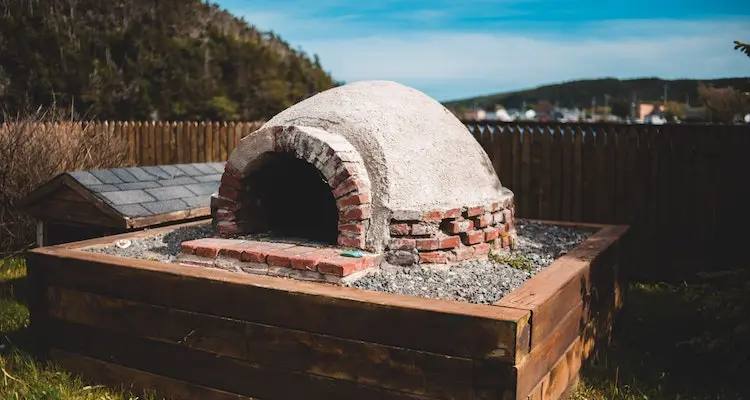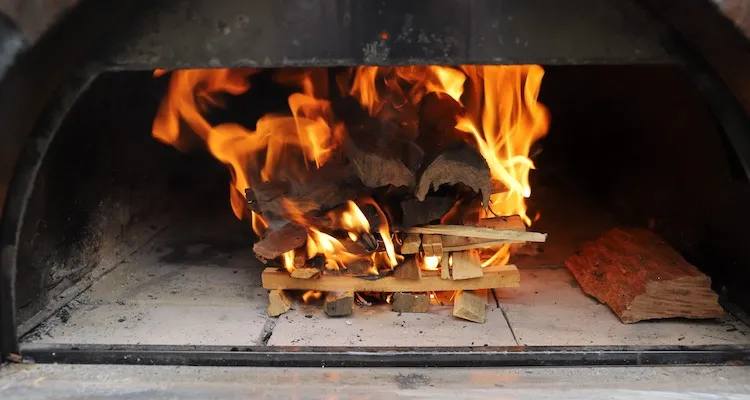If you’re looking for a backyard pizza oven, you’ve got a pretty important choice to make; steel or brick.
You could just punt, but without knowing the difference between the two, your pizza making session will always be tainted by the haunting idea that you might have chosen the wrong oven.
Thankfully, we’re here to squash that potential anxiety and give you all the information you need to choose the right pizza oven material for you.
Brick vs stainless steel pizza oven: what’s the difference?
Before we address the elephant in the room, which oven makes better pizza, let’s first take a look at both types of oven and their pros and cons.
Brick pizza ovens
A traditional brick pizza oven works on thermal mass and retained heat. To put it simply, when you light the fire in a brick pizza oven, the heat is absorbed by the structure of the oven, stored, and reflected during cooking.
Bricks work well for cooking purposes because they have a high thermal mass, which is the ability of a material to absorb and store heat energy.

It takes a lot of time and thermal energy to heat a brick oven properly. When it’s finally up to cooking temperature, your pizza base is cooked from below by the fire’s heat, and the toppings are cooked by heat stored and emitted by the bricks, ensuring both high temperatures and consistent cooking.
The traditional dome at the top of a pizza oven helps the process by reflecting heat back down on the top of the pizza.
However, all this wonderful thermal mass comes with two significant drawbacks. Firstly, as we mentioned, brick pizza ovens take a long time to hit the 330℃ (625℉) that Italian pizzaiolos claim as the perfect temperature for cooking pizza.

You could be looking at a pre-heat period of 30 to 60 minutes depending on the size of your oven.
Secondly, if you’re hoping for a portable pizza oven, brick is not your friend. Brick ovens work best as permanent fixtures because of their immense weight.
Many brick ovens will also require a curing process, which means lighting progressively larger fires over the course of a few days to thoroughly drive any moisture out of the bricks to prevent cracking.
You’ll also need to take care to shield your brick oven from the elements, as moisture and cold temperatures can erode the brickwork and potentially cause enough thermal stress to crack the oven when you fire it up.
Stainless steel pizza ovens
Where brick ovens function on thermal mass, stainless steel ovens work on heat reflection. Steel heats up comparatively quickly and is both an excellent reflector and conductor of heat.

Steel ovens don’t need to be cured, so you can buy one in the afternoon and be cooking on it by dinner time, and they also heat up very quickly. The price you pay for that element of instant gratification is that steel doesn’t have a high thermal mass, so it cools down quickly as well.
That rapid cooling means you might have to reheat the oven slightly between cooking pizzas or run the risk of your base and toppings cooking at different rates. The good news is that the reheating process is quick.
If you want a portable pizza oven, steel is probably the best bet. Unlike brick ovens, your steel pizza oven doesn’t have to be a permanent addition to your yard.
Many stainless steel pizza ovens are built on a wheeled base, so they can be easily rolled back into a covered space or garage to protect them from the elements. You can also get smaller, countertop pizza ovens made from stainless steel like the Ooni Pro multi-fuel oven.
Steel ovens are a lot easier to move and are great if you don’t have a lot of time to thoroughly preheat your oven, but they do lack some of the esthetics of a traditional brick oven.
Which oven is best for cooking pizza?
Cooking pizza in a relatively simple oven using wood as a fuel is an inherently unpredictable process. Different woods, different pizza flours, and various oven types throw out so many variables that it is impossible to point to one construction material and call it better than another.
A semolina pizza cooked in a brick oven over beechwood in Texas is going to be distinctly different from a 00 flour pizza cooked over maple in Vermont, even if they’re both cooked in the same oven.
That being said, when it comes to choosing between steel and brick, there are two main factors to consider.
The first factor is convenience.
| Brick | Steel |
|---|---|
| Brick ovens take longer to heat up, need to be cured before you can cook in them, and need more protection from the elements. You’re also not going to be taking them to your friend’s cookout without the need for a JCB. |
Steel ovens heat up quickly, can be used on the day they are brought, and some even come with wheels for easy portability. So a steel oven is easily the more convenient option. |
The second factor is consistency.
| Brick | Steel |
|---|---|
| Brick ovens hold heat exceptionally well, so if you’re cooking a mass of pizzas, you won’t need to stop to reheat. They can also have a more consistent cooking environment, especially in colder climates, because of their higher thermal mass. |
Steel ovens lose heat almost as fast as they heat up, so you can’t expect to shovel a street party’s worth of pizza’s through it without a little reheating in between. |
Wrapping it all up
To sum it all up. Brick ovens make an excellent permanent emplacement for someone with enough time and patience to deal with their long preheat time and enough hungry mouths to want to cook a lot of pizzas.
Some people also prefer the more rustic aesthetic of brick to the more modern lines of most steel ovens.
Steel ovens are great for pulling out on a sunny day and packing away again when you’re done. They heat up fast, which means more instant pizza gratification, but they also cool quickly, which means cooking pizzas in bulk is a longer and more fiddly process than with a brick oven.
If one of those sets of benefits stands out to you and your particular circumstances, then that’s the pizza oven for you!
If you’ve got a brick or steel pizza oven and have some tips on how to get the best out of it, we’d love to hear about it in the comments section below.